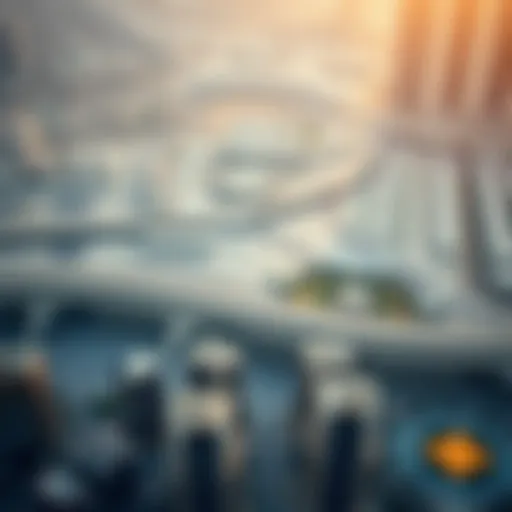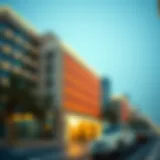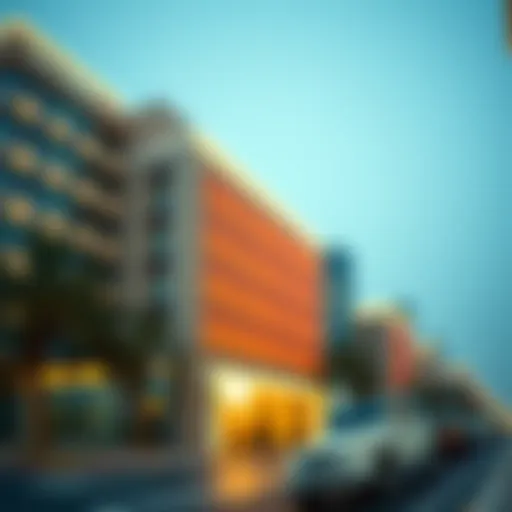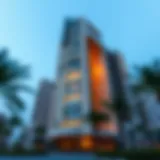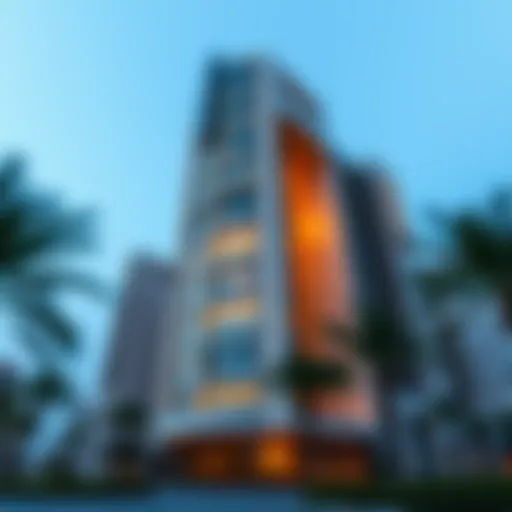Dubai's Urban Landscape: Innovation Meets Tradition


Intro
Dubai, a city risen from the desert sands, stands as a testament to what modern urban planning can achieve. It’s not just the skyscrapers or the luxury shopping malls that catch one's eye, but a multifaceted urban tapestry rich with cultural influences and breathtaking architectural feats. This piece aims to explore how such intense development blends together contemporary design, economic growth, and a myriad of cultural threads, defining what Dubai has become today.
The blend of opulence and tradition in Dubai’s cityscape paints a vivid picture worthy of detailed inquiry. From the moment you set foot in Dubai, there’s a palpable sense of dynamism — the constant buzz of growth and innovation. This article seeks to uncover various layers of this urban phenomenon, guiding you through notable neighborhoods, investment hotspots, and the challenges that lie ahead in this swiftly changing environment.
As the world’s gaze shifts towards Dubai, understanding its unique market trends and investment opportunities becomes increasingly crucial for stakeholders ranging from homebuyers to global investors. Let’s take a closer look at the currents reshaping this metropolis.
Market Trends and Insights
Current Market Conditions
In recent years, Dubai's real estate market has shown resiliance amidst various global economic challenges. With an influx of expatriates and a steady stream of tourists, demand for both residential and commercial properties has remained robust. Presently, play a significant role in maintaining competitive pricing and quality of construction.
"The real estate market in Dubai serves as a mirror to the global economic environment, reflecting shifts and trends that guide investment decisions."
Factors influencing current market conditions include:
- Low interest rates: Encourage borrowing, facilitating property purchases.
- Government incentives: Initiatives like the Golden Visa attract long-term investors and skilled labor.
- Diverse portfolio: Growing sectors like tech and tourism are increasing the demand for specific types of properties.
Future Predictions and Projections
Looking ahead, experts foresee Dubai continuing its trajectory as an international business hub. The next several years will be pivotal, marked by innovations that will expand its urban fabric. Some key projections include:
- Continued investment in infrastructure projects aimed at improving city connectivity.
- Growth in sustainability initiatives, driving demand for eco-friendly developments.
- An expected increase in remote working accommodations, as companies adapt to new work models.
Understanding these trends not only helps investors but also shapes the strategies that developers should adopt moving forward.
Investment Opportunities
Emerging Neighborhoods
As Dubai evolves, so too do its neighborhoods, each boasting unique characteristics that attract diverse demographics. Some notable areas to watch include:
- Dubai Creek Harbour: Blending modernity with nature, offering waterfront living.
- Jumeirah Village Circle (JVC): Gaining popularity among families and affordable housing seekers.
- Dubai South: Positioned to thrive with its proximity to the Expo 2020 site and Al Maktoum International Airport.
These neighborhoods are not just investment hotspots but are also designed to foster a sense of community.
Types of Properties to Invest In
Investors are presented with a plethora of options when considering property types. Below are the primary categories that stand out:
- Luxury Villas: Ideal in areas like Emirates Hills, these properties cater to affluent buyers.
- High-Rise Apartments: Perfect for city dwellers, particularly around Business Bay.
- Commercial Spaces: The demand for office spaces remains steady, especially in tech and innovation hubs.
The key to successful investment in Dubai lies in recognizing emerging trends and aligning them with the city's ambitious development plans.
The Evolution of Dubai's Urban Landscape
The transformative journey of Dubai's urban landscape serves as both a reflection of its ambitious vision and a response to the needs of a diverse population. The city has morphed from a quiet fishing village into a bustling metropolis, showcasing not only innovation in construction but also a deep entanglement with global economic dynamics. This evolution is important because it illustrates the interplay between cultural identity and modernization, which can serve as a blueprint for other cities in their development journeys.
Historical Context
To understand Dubai's current urban fabric, one must first grasp its historical roots. The region's strategic location along ancient trade routes played a crucial role in its early growth, fostering commerce and cultural exchanges among different civilizations. The discovery of oil in the 20th century marked a significant turning point, leading the local rulers to invest in infrastructure and attract international businesses. By the late 1960s, initiatives to build modern amenities and facilities paved the way for a city that embraced progress while respecting its historical narrative.
Dubai’s growth wasn’t just a fortuitous byproduct of oil wealth; it was a product of thoughtful planning and decisive leadership. Sheikh Rashid bin Saeed Al Maktoum, the former ruler, famously stated, "My grandfather rode a camel, my father rode a camel, I fly a plane. My son flies a jet, and his son will ride a spaceship." This anecdote encapsulates Dubai's visionary approach and serves as a reminder that success does not occur in isolation; it arrives through collaborative efforts across generations.
Key Milestones in Development
It’s through various milestones that one can trace the remarkable evolution of Dubai’s urban landscape. Some of these pivotal moments include:
- The Construction of the Dubai Creek (1960s): This project was both symbol and function; it facilitated trade while also positioning Dubai as an emerging port city.
- The Launch of the Dubai Airport (1960): Enabling international access, this feat marked the first major infrastructural lift, solidifying Dubai's place on the map for globetrotting business and leisure travelers alike.
- The Creation of the Burj Khalifa (2010): Not merely the tallest building in the world, the Burj Khalifa has become a global icon of ambition, pushing architectural limits and transforming the skyline.
- The Opening of The Palm Jumeirah (2006): This reclaimed island showcases Dubai's ingenuity in urban planning, combining luxury with leisure and becoming a magnet for tourists.
These milestones are not just about bricks and mortar; they depict a profound commitment to innovation that weaves together commerce, tourism, and culture.
Architectural Influences
Dubai’s architectural narrative is as diverse as its populace. The city stands as a melting pot of styles, integrating elements from both local and international design philosophies.
- Islamic Architecture: Islamic influences can be seen in many structures, characterized by intricate geometric patterns, elaborate minarets, and spacious courtyards. The Jumeirah Mosque, a dazzling example, embodies this tradition while welcoming tourists to appreciate its beauty.
- Modernism and Futurism: The Burj Al Arab, shaped like a sail, epitomizes contemporary design. Its luxurious offerings are matched by its striking form, a blend of functionality and visual allure.
- Sustainable Design: An emerging trend in Dubai's architectural evolution is sustainability. Projects like the Sustainable City are cultivating a future where urban living aligns with environmental stewardship.
The architectural diversity found in Dubai’s landscape allows for an enriched urban experience, showcasing how design can stimulate both economy and culture.
"Architecture should speak of its time and place, but yearn for timelessness." - Frank Gehry
Iconic Structures and Landmarks
The influence of iconic structures and landmarks on the urban landscape of Dubai can hardly be overstated. These edifices not only define the skyline but also encapsulate the city's ambitions and cultural aspirations. They act as magnets for tourism, investment, and international attention, shaping both social interactions and economic activities. From towering skyscrapers that scrape the clouds to luxury resorts that epitomize opulence, each landmark tells a story of architectural evolution, innovative engineering, and cultural significance.
Burj Khalifa: The Pinnacle of Modern Design
Standing as a testament to human ingenuity, Burj Khalifa dwarfs its surroundings, reaching a staggering height of 829.8 meters. Completed in 2010, it was designed by Adrian Smith of Skidmore, Owings & Merrill, showcasing a blend of art and engineering that has set new standards worldwide. The structure houses a mix of residential, commercial, and hospitality spaces, providing a glimpse into the multifaceted lifestyle of Dubai.
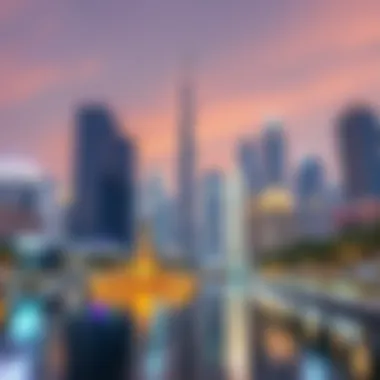

The building's design takes inspiration from traditional Islamic architecture, particularly evident in the geometric patterns prominent on its exterior. This aspect is not merely aesthetic; it intertwines with the cultural identity of the region, reminding residents and visitors alike of Dubai's rich heritage. More than just a place to work or live, it offers breathtaking views from its observation deck, drawing millions of visitors each year.
Additionally, the Burj Khalifa is emblematic of Dubai's economic progression. It stands as a beacon of opportunity, illustrating the possible heights of achievement in a city that was once a modest trading port.
The Burj Al Arab: A Symbol of Luxury
Known as the most luxurious hotel in the world, the Burj Al Arab captivates with its unique sail-shaped silhouette and lavish services. Opened in 1999, it was designed by architect Tom Wright and has since become an icon of opulence. The hotel is situated on an artificial island, accessible only by a private bridge, emphasizing its exclusive nature.
Inside, the luxury is palpable: each suite is a world unto itself, featuring amenities like a private butler service and panoramic views of the Arabian Gulf. Dining options include a variety of high-end restaurants, with the underwater Al Mahara standing out, where guests can dine amidst a mesmerizing marine environment.
This establishment has indeed set the stage for Dubai as a high-end travel destination, attracting wealthy tourists and global business leaders. The mere mention of the Burj Al Arab evokes images of grandeur, making it a critical player in shaping the city’s identity as a luxury hotspot.
Dubai Marina: A Fusion of Nature and Urbanity
Dubai Marina serves as an idyllic example of where urban planning meets nature. Launched in the early 2000s, this district has rapidly evolved into a prestigious community, encompassing residential spaces, commercial areas, and meticulously landscaped parks along the waterfront. It features an impressive man-made marina that allows residents and tourists to relish both the skyline and serene waters not far from the bustling city center.
What sets Dubai Marina apart is its lifestyle. It offers a perfect blend of relaxation and vibrancy, bringing together leisure attractions like beaches, cafes, and promenades. The intricate design encourages socialization and activity, creating a safe and inclusive environment for its diverse inhabitants. Every evening, the area transforms as residents and visitors come to enjoy the picturesque views, further enhancing the appeal.
From yacht parties to tranquil walks along the water, Dubai Marina illustrates how urbanization can coexist with natural beauty, reinforcing the notion that modern developments need not sacrifice the environment for luxury.
"Dubai Marina is a testament to modern urban design, showcasing how space can be utilized effectively while preserving an enjoyable living experience."
In summary, the iconic structures of Dubai offer more than visual appeal. They are deeply woven into the fabric of the city, shaping cultural narratives and driving economic growth. Each landmark speaks to the city’s past while simultaneously paving the way for its future.
Neighborhood Dynamics
The structure and function of neighborhoods within any urban landscape hold immense significance. In Dubai, understanding the dynamics of its neighborhoods sheds light on the overarching identity of the city, its cultural fabric, and socio-economic trends. These areas are not merely geographic divisions; they offer insights into the lifestyle, aspirations, and demographics of the inhabitants. The neighborhoods in Dubai are distinct in character, ranging from bustling commercial hubs to serene coastal retreats. This section offers a closer look at how these dynamics play out in influencing both the local and broader socio-economic environments.
Downtown Dubai: The Heart of the City
Downtown Dubai stands as the epitome of modern urban planning and architectural excellence. Stretching around iconic structures like the Burj Khalifa, this area pulsates with life and activities. Here, skyscrapers are not just residential or commercial buildings; they are landmarks that draw tourists and represent investment opportunities. The transformative nature of Downtown Dubai lies not only in its visual appeal but also in its role as a major economic engine.
Furthermore, it serves as a major retail and entertainment hub, attracting both locals and visitors to the Dubai Mall, one of the largest shopping centers in the world. With options for leisure and dining, Downtown provides a lifestyle that caters to diverse demographic groups. It's no wonder that this neighborhood is described as the heart of the city. The vibrant atmosphere encourages social interactions, fostering community ties that contribute to a thriving metropolitan landscape.
Jumeirah: Coastal Luxury
On the opposite end of the spectrum lies Jumeirah, an area synonymous with coastal luxury. Known for its breathtaking beaches and opulent resorts, Jumeirah has established itself as a prime location for affluent locals and expatriates. The neighborhood encapsulates the essence of Dubai's exotic lifestyle, where the Mediterranean-inspired architecture complements the azure waters of the Arabian Gulf.
Living in Jumeirah means being part of a community that places a high value on leisure and exclusive experiences. From high-end boutiques to gourmet restaurants, everything in Jumeirah speaks to sophistication and recoginition of life’s pleasures. Not to mention, the sprawling beach parks offer a respite from urban hustle, making it an ideal place for families. The presence of luxury villas and serviced residences also highlights the real estate's high-value market, attracting keen investors looking for lucrative opportunities.
Deira: Traditional Meets Modern
In stark contrast to the lavishness of Jumeirah is Deira, a neighborhood that carries the weight of Dubai's historical roots while embracing modernization. Deira remains the city’s traditional heart, where bustling souks and warm hospitality dominate the streets. Here, you can find the Gold Souk and Spice Souk, where the aroma of spices fills the air and the allure of gold captivates shoppers.
Deira demonstrates a flourishing blend of old-world charm and contemporary conveniences. The neighborhoods are undergoing significant urban transformations, attracting investments that promise to elevate the standard of living while preserving cultural heritage. New residential developments cater to a diverse population, making it a melting pot of cultures and traditions. This aspect not only provides opportunities for economic growth but also fosters a sense of community amid diversification.
Ultimately, as we traverse the different neighborhoods of Dubai, it becomes evident that their dynamics are interwoven with the city’s overall narrative. The rich contrasts among them contribute to a vibrant urban fabric—balancing tradition and modernity while catering to a range of lifestyles and economic aspirations.
The Economic Landscape of Dubai
Dubai's economic landscape is a dynamic framework that functions as both a magnet for investment and a platform for growth. The confluence of various elements within this framework not only enhances the city's appeal to global investors but also shapes the very urban fabric of Dubai itself. Among the bustling skyscrapers and luxury malls lies an intricate network of commerce and opportunity, making it essential to understand the landscape in its entirety. No longer just a trading post, Dubai embodies a thriving metropolis that represents a model for economic diversification and resilience.
Real Estate Market Trends
The real estate market in Dubai has seen a transformative evolution over the past few decades, marked by fluctuating prices and various regulatory changes. Given its strategic location, investors find Dubai's market appealing for both residential and commercial properties. Notably, the introduction of regulations allowing foreign ownership in certain areas has contributed to a significant surge in demand.
- Price variations are typically influenced by global economic shifts, showcasing a correlation with markets in Europe and Asia.
- Luxury properties, like those in the Burj Khalifa locale, continue to attract high-net-worth investors, highlighting the city's allure.
In recent years, the trend is leaning towards sustainable developments, intertwining technological advancements with environmental considerations. Projects such as the Dubai Creek Tower focus not just on height but on integrating innovative green technologies.
Investment Opportunities
Investors looking at Dubai can find a treasure trove of opportunities across various sectors. The government’s proactive stance on facilitating business activities has led to an enhanced environment for investment.
- Free Zones: Specific areas like the Dubai International Financial Centre (DIFC) offer tax exemptions and 100% foreign ownership, appealing to international businesses.
- Technology and Innovation: Startups in fintech and artificial intelligence are booming, fueled by significant venture capital investments and government support.
- Mixed-Use Developments: Integrated communities that combine residential, retail, and leisure options are becoming increasingly popular, making them ideal for real estate investors.
Such investment options not only promise potential financial returns but also enrich the urban environment, fostering a more diverse economy.
Impact of Tourism on Urban Development
Tourism stands as a cornerstone of Dubai's economy, significantly impacting urban development. With millions flocking to the city each year, the demand for luxury hotels, cultural institutions, and recreational spaces has consequently driven real estate expansion.
- The strategic positioning of attractions, like the Dubai Mall and the Palm Jumeirah, has created a ripple effect, encouraging mixed-use developments nearby.
- Additionally, the recent focus on promoting cultural tourism has led to the establishment of museums and galleries that celebrate both local heritage and international art forms.
"Tourism is like blood for Dubai’s economy; it invigorates its growth and fuels its ambitions."
Furthermore, events like Expo 2020 have catalyzed infrastructure improvements, enhancing connectivity and public services in the area.
By establishing a symbiotic relationship between tourism and urban development, Dubai continues to redefine its economic narrative in the global arena.
Cultural and Recreational Spaces
Cultural and recreational spaces play a pivotal role in the development of vibrant urban environments, particularly in a city as dynamic as Dubai. These areas not only provide essential leisure and recreational opportunities but also foster community engagement and cultural enrichment. With Dubai’s rapid growth and transformation into a global metropolis, the integration of cultural and recreational spaces has become increasingly relevant. Investors, homebuyers, and developers ought to understand the importance of these spaces as they contribute significantly to the overall quality of life, making the city more attractive to residents and tourists alike.
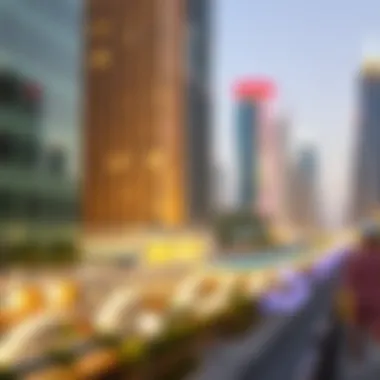

The Role of Parks in Urban Life
Parks serve as the lungs of urban areas, offering residents a respite from the hustle and bustle of city life. In Dubai, parks are not merely patches of green; they are thoughtfully designed spaces that encourage social interaction and physical activity. From the sprawling Al Barsha Park to the picturesque Dubai Creek Park, these green lungs cater to various demographics with amenities like jogging tracks, children's play areas, and picnic spots.
Benefits of parks extend beyond aesthetics:
- Mental Health: Access to greenery reduces stress levels and boosts mental well-being. In the intensely urban fabric of Dubai, parks offer an oasis for relaxation and connection to nature.
- Community Bonds: Events held in parks, like markets or art fairs, foster community spirit and solidarity among residents.
- Wildlife Habitats: Select parks integrate natural ecosystems, offering educational opportunities about local flora and fauna.
Moreover, the city's commitment to expanding and maintaining parks aligns with its sustainability goals. Tall palm trees and botanical gardens enhance not just the beauty but also the ecological balance of urban life.
Cultural Institutions: A Hub for Art and Heritage
Cultural institutions in Dubai, such as the Dubai Opera and the forthcoming Museum of the Future, demonstrate the city's dedication to showcasing art and heritage. These venues go beyond traditional concepts of museums; they are dynamic spaces that breathe life into the art scene, attracting both local and international talent.
- Art Exhibitions: Regular exhibitions help cultivate a culture of appreciation for local artists and global talents, providing critical exposure.
- Workshops and Programs: These institutions often host workshops, making art accessible to all ages. Communities benefit from learning opportunities that enhance cultural appreciation and skill-building.
- Heritage Promotion: Cultural venues play a role in preserving local history, offering insight into Dubai’s rich past through engaging storytelling and interactive displays.
Investment in such institutions is a testament to Dubai’s aspiration to be seen not just as a business hub but as a cultural beacon of the region.
Entertainment Venues and Their Impact
Entertainment venues are vital cogs in Dubai’s urban machinery, offering a diverse range of experiences that cater to various tastes. From theaters and concert halls to indie cinemas and massive shopping malls, these spaces bring vibrancy and energy to the city.
- Economic Boost: Such venues generate significant revenue, creating jobs and attracting tourists. The economic impact is multifold, contributing to the hospitality and retail sectors.
- Cultural Exchange: Events ranging from film festivals to musical performances facilitate cultural exchanges between residents and visitors. This mix fosters an environment enriched by diversity and artistic expression.
- Community Engagement: Many venues organize community events that invite local participation, strengthening social ties and promoting inclusivity.
Ultimately, Dubai's approach to integrating cultural and recreational spaces underscores its commitment to sustainable urban living. With ongoing projects and enhancements, the city's future appears poised to include even more inclusive and enriching spaces for all.
"A well-designed urban park can positively impact a city's health and aesthetics while promoting social cohesion."
For further insights on cultural institutions in Dubai, you might visit Wikipedia or Britannica. Explore discussions about these spaces on platforms like Reddit and follow developments through local government initiatives at Dubai Government's website.
By appreciating the complexity and necessity of these cultural and recreational spaces, investors and developers can better navigate the unique residential landscape that Dubai presents.
Transport Infrastructure
Transport infrastructure represents the backbone of any urban setting, including Dubai, where the seamless movement of people and goods is an essential pillar of its economic vitality. Dubai’s infrastructure has undergone tremendous evolution, becoming a sophisticated network that supports its rapid growth and increasing population. This section is devoted to unpacking the various levels of public transport systems, road networks, and their respective roles in shaping urban mobility in Dubai.
Public Transportation Systems
Dubai’s public transportation system is a remarkable feat of modern engineering and design, featuring the Metro, buses, and water taxis. The Dubai Metro, known for its driverless technology, is one of the longest automated metro systems in the world. It comprises two main lines, the Red and Green lines, which together traverse through key areas of the city, enhancing connectivity.
- Dubai Metro: Efficiency is key here, reducing travel time dramatically across the bustling city.
- Buses: The bus network complements the metro service, offering extensive routes to reach almost every corner of the city.
- Water Taxis: These present a scenic and alternative means of travel across Dubai's waterways.
"A city’s transportation framework significantly influences its social and economic dynamics. A robust public transport system facilitates easy access and enhances quality of life."
Road Networks and Connectivity
The road networks in Dubai are extensive, characterized by wide avenues and major highways, enabling quick access to all major districts. Sheikh Zayed Road stands out as the principal artery, lined with skyscrapers and prominently connecting various business hubs.
Consider the following:
- Strategic Planning: Roads are designed for efficiency, with numerous interchanges that cut down travel time.
- Traffic Management: Smart traffic management systems have been put in place, which monitor vehicle flow and adjust signals accordingly to minimize congestion.
- Linking Key Zones: These roads facilitate connectivity between the airport and business districts, ensuring that economic activities are seamlessly integrated.
Impact of Transportation on Urban Mobility
Transportation in Dubai does not just serve a functional purpose; it shapes urban life. The influence of effective transport systems on urban mobility is profound:
- Accessibility: Easier access to services and amenities boosts real estate values and stimulates local economies.
- Environmental Consideration: By promoting public transport, Dubai works towards mitigating environmental impact, steering the city away from car dependency.
- Global Competitiveness: A well-connected city attracts investments, making it an appealing destination for businesses.
The integration between various transportation modes ensures that residents and visitors alike can navigate the city with relative ease, embodying the urban fabric of Dubai as a dynamic and accessible metropolis. Enhanced transport infrastructure not only sustains economic growth but also enhances daily life, shaping the future trajectory of the city’s development.
For further information and resources on urban transport infrastructure, you may visit:
Wikipedia on Public Transport in Dubai
Dubai’s Roads and Transport Authority
Britannica Article on Dubai
City Transport Forum on Reddit
Now, let's explore the next imperative section next step.
Sustainability Efforts in Urban Design
The rapid growth of Dubai into a global city brings with it the importance of sustainable urban design. Balancing urban expansion with ecological responsibility is more than just a trend; it's crucial for the city's long-term viability. As desert climates become increasingly susceptible to environmental changes, adopting sustainable practices in urban planning is not just benefical but essential.
In this context, several initiatives showcase Dubai’s commitment to sustainability, including green building practices, water conservation strategies, and effective management of urban heat. Emphasizing these elements not only improves the quality of life for residents but also attracts investors who prioritize sustainability.
Green Building Initiatives
Green building in Dubai has gained momentum, driven by both public sector policies and private sector innovation. Initiatives such as the UAE Green Building Code aim to drive energy efficiency and sustainable materials. These regulations encourage construction that minimizes environmental impact. For instance, towers like the Burj Khalifa utilize double-glazed glass, reducing heat absorption and enhancing energy efficiency.
Key Elements of Green Building Initiatives:
- Energy Efficiency: Utilizing renewable energy sources, like solar panels, has become common in many new developments.
- Sustainable Materials: Focusing on local and recycled materials reduces transportation costs and energy, thereby minimizing the carbon footprint.
- Certification Programs: The Estidama rating system has been implemented in Abu Dhabi, and Dubai has similar measures to recognize sustainable practices.
Incorporating these elements not only meets regulatory demands but resonates with an audience increasingly concerned about environmental impact.
Water Conservation Strategies
Water scarcity is a pressing concern in Dubai, given its arid climate. Innovative water conservation strategies are essential in urban planning. The Dubai Water and Electricity Authority (DEWA) has launched initiatives like the Water Efficiency Strategy 2030, aiming to reduce per capita water consumption by 30%.


Practical Strategies Include:
- Reclaimed Water Usage: Using treated wastewater for irrigation purposes conserves potable water.
- Smart Technology: Installing smart meters helps identify leaks and optimize usage across households and businesses.
- Public Awareness Campaigns: Educating citizens on the importance of water conservation fosters community participation in sustainability efforts.
These strategies collectively allow Dubai to address its critical water issues while paving the way for a sustainable urban future.
Urban Heat Management
Managing urban heat is vital for a city that often experiences extreme temperatures. The phenomenon of urban heat islands, where city areas become significantly warmer than surrounding rural areas, poses serious challenges to residents and infrastructure alike.
To mitigate this effect, Dubai has invested in several urban heat management strategies:
- Green Roofs and Walls: Incorporating vegetation on rooftops and vertical surfaces helps cool buildings naturally while improving air quality.
- Reflective Materials: Many new constructions are designed with reflective materials to minimize heat absorption, thus reducing the demand for air conditioning.
- Urban Forests: Planting trees in public spaces not only provides shade but also contributes to the overall biodiversity.
"Sustainable design is not just a choice; it's a necessity for urban environments facing climate challenges."
These strategies provide immediate relief from extreme heat and contribute to the overall sustainability of the urban environment. The shift toward environmentally conscious practices in Dubai reflects a growing understanding of the interconnectedness of city planning and ecological balance.
In summary, sustainability in urban design is about creating a livable, resilient city. By emphasizing green building initiatives, water conservation strategies, and urban heat management, Dubai is setting a standard for modern cities worldwide.
Challenges Faced by the City
The rapidly evolving city of Dubai, while often celebrated for its skyscrapers and luxury lifestyles, faces a variety of challenges that are crucial to understand in the context of its urban fabric. Recognizing these challenges not only helps to appreciate the city’s dynamic environment but also reinforces the need for sustainable growth, social equity, and environmental stewardship. The following sections delve into three primary challenges: economic volatility, social disparities, and environmental concerns. Each aspect contributes to the complexity of Dubai's urban development and has implications for investors, residents, and policymakers.
Economic Volatility
Economic volatility poses a significant challenge for Dubai, given its heavy reliance on sectors like tourism, real estate, and trade. Fluctuations in oil prices, changing global market conditions, and sudden geopolitical events can create ripples that affect investments, job security, and overall economic stability.
The real estate market, for instance, has seen periods of both rapid growth and sharp declines. Events like the 2008 global financial crisis serve as a reminder of how quickly the landscape can change. Investors must navigate these ups and downs carefully, staying informed about market trends and regulatory changes. They should also be wary of potential bubbles in property prices and the risks associated with speculative investments.
Moreover, as Dubai continues to diversify its economic base, challenges remain in attracting sustainable businesses that provide long-term job security. Innovation in sectors like technology and renewable energy could play a pivotal role in buffering against economic shocks.
Social Disparities
Despite its glittering facade, social disparities in Dubai are ever-present. The city houses a large expatriate population, often working in low-wage positions without equal access to resources that more affluent residents enjoy. This dynamic creates a societal divide that can lead to tensions among different demographic groups.
Housing is a prime example. While luxury developments like the Palm Jumeirah attract wealthy buyers, many workers in the city reside in substandard areas far from their workplaces, underlining a stark contrast in living conditions. The government has been making efforts to improve affordable housing options, but providing equitable opportunities for all residents remains a pressing challenge.
Furthermore, this divide affects local culture and community engagement. Many expatriates may feel detached from the city’s more affluent cultural narratives, resulting in a disconnect that can impact social cohesion.
Environmental Concerns
As a desert metropolis, Dubai grapples with several environmental challenges that complicate urban planning and sustainability efforts. Water scarcity is a major concern, compounded by rapid urban sprawl and growing population demands. The reliance on desalination plants, while innovative, carries significant environmental and economic costs.
Additionally, the urban heat island effect is increasingly pronounced due to extensive concrete surfaces and high energy consumption for air conditioning. This phenomenon can raise temperatures in urban areas, worsening local climate conditions and impacting residents’ quality of life.
Efforts to mitigate these issues include the implementation of green building initiatives, promoting water conservation strategies, and investing in urban greening programs. There’s no overnight solution, and it requires the joint efforts of residents, businesses, and the government to ensure that environmental sustainability is at the forefront of future urban development.
In summary, while Dubai stands at the crossroads of luxury and innovation, addressing these challenges is paramount for its sustainable growth and social harmony.
By recognizing the intricate issues of economic volatility, social disparities, and environmental concerns, stakeholders can work together to develop solutions that benefit all facets of society. Understanding these elements helps investors and policymakers create strategies that not only promote economic success but also ensure the city remains a vibrant, diverse, and sustainable urban landscape.
By targeting reliable sources and fostering inclusive community engagement, Dubai can aim to address its challenges effectively while paving the way for a more equitable and sustainable future.
For more information, consider exploring resources like Wikipedia and Britannica for a deeper understanding of Dubai’s evolving challenges.
Future Prospects for Urban Development
Addressing the future of urban development in Dubai is not just key; it’s tantamount to understanding how this dazzling city will continue to evolve. The vibrant blend of culture, wealth, and architectural innovation characterizes Dubai. As it moves forward, specific elements will play a pivotal role in shaping its urban landscape. Understanding these prospects can provide insight for investors, homebuyers, and developers keen on capitalizing on the city's ever-changing dynamic. Overall, the future shines bright, and the urban prospects look promising due to technological advancements and strategic planning.
Smart City Initiatives
Dubai has launched a series of smart city initiatives aimed at enhancing the quality of life for its residents while promoting sustainability. These projects focus on integrating technology into everyday urban environments, making them more efficient and responsive to the needs of the population. For example, the Smart Dubai initiative envisions a city that connects everything from public services to personal devices.
Key features of this initiative include:
- Real-time data usage for city planning and management.
- Smart transportation systems to reduce traffic congestion and improve mobility.
- Sustainability efforts that integrate renewable energy sources into city planning.
Implementing smart sensors across neighborhoods allows for enhanced public services. Citizens can receive updates on public transport, environmental conditions, and even local events right in the palm of their hands. With the incorporation of such technology, Dubai is being positioned as a model for other cities worldwide, effortlessly intertwining everyday life with digital innovation.
Long-term Urban Planning Strategies
The essence of Dubai's successful urban development lies in its astute long-term planning strategies. City planners are focusing on various elements that provide a framework for sustainable and inclusive growth. This involves a multidisciplinary approach combining urban design, environmental sustainability, and social equity.
Some considerations in Dubai’s long-term planning strategies include:
- Zoning laws that balance residential and commercial zones while focusing on mixed-use developments.
- Public transport infrastructure aimed at reducing reliance on private vehicles, thereby promoting eco-friendly commuting.
- Community-focused spaces that strengthen social ties among residents and ensure access to amenities.
These elements not only cater to current needs but also anticipate the demands of future generations, ensuring that urban planning evolves alongside the growing population.
Predicted Trends in Real Estate
As Dubai rolls into the next decade, several trends are set to reshape its real estate landscape. Continuous investment remains pivotal, allowing for detailed analyses of potential market conditions. Noticing predicted shifts helps investors and analysts make sound financial decisions.
- Sustainable developments will gain momentum. Buyers are becoming increasingly conscious of ecological footprints, thus driving demand for green buildings.
- Technological integration will become commonplace, directing preferences toward properties with smart home features and connectivity.
- Co-living and hybrid spaces are likely to rise in popularity, particularly among millennials and the younger population who seek flexibility and community.
Understanding these trends can give insight to developers looking to invest wisely in the booming market while keeping an eye on consumer preferences.
"In every city, the future should be as bright as the skyline, and in Dubai, that future is being built with precision and ambition."

